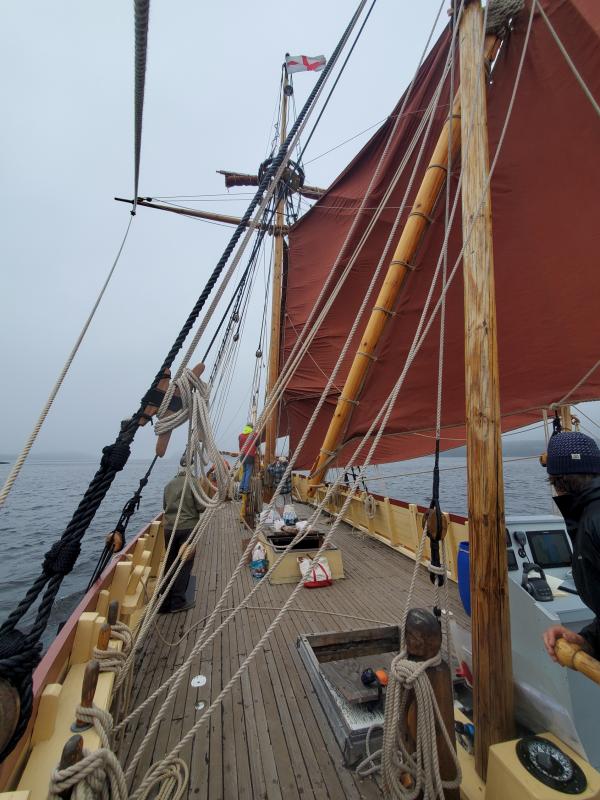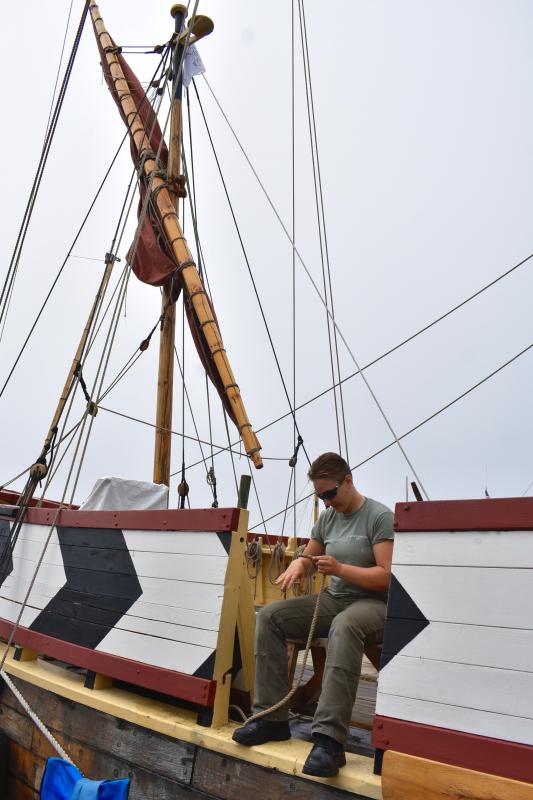Virginia sets sail for first time
 The Virginia, a replica of a 1608 vessel, sits in Boothbay Harbor during Windjammer Days. FRITZ FREUDENBERGER/Boothbay Register
The Virginia, a replica of a 1608 vessel, sits in Boothbay Harbor during Windjammer Days. FRITZ FREUDENBERGER/Boothbay Register
 Virginia under sail getting ready to enter the Sheepscot River. Keith Spiro Media photo
Virginia under sail getting ready to enter the Sheepscot River. Keith Spiro Media photo
 The Virginia. FRITZ FREUDENBERGER/Boothbay Register
The Virginia. FRITZ FREUDENBERGER/Boothbay Register
 Rowan Blaiklock, a volunteer with Virginia, helps mend rope. FRITZ FREUDENBERGER/Boothbay Register
Rowan Blaiklock, a volunteer with Virginia, helps mend rope. FRITZ FREUDENBERGER/Boothbay Register
 The Virginia, a replica of a 1608 vessel, sits in Boothbay Harbor during Windjammer Days. FRITZ FREUDENBERGER/Boothbay Register
The Virginia, a replica of a 1608 vessel, sits in Boothbay Harbor during Windjammer Days. FRITZ FREUDENBERGER/Boothbay Register
 Virginia under sail getting ready to enter the Sheepscot River. Keith Spiro Media photo
Virginia under sail getting ready to enter the Sheepscot River. Keith Spiro Media photo
 The Virginia. FRITZ FREUDENBERGER/Boothbay Register
The Virginia. FRITZ FREUDENBERGER/Boothbay Register
 Rowan Blaiklock, a volunteer with Virginia, helps mend rope. FRITZ FREUDENBERGER/Boothbay Register
Rowan Blaiklock, a volunteer with Virginia, helps mend rope. FRITZ FREUDENBERGER/Boothbay Register
Among sleek sloops, yawls and yachts charming Boothbay Harbor during Windjammer Days, one ship looked quite a bit older. A little rounder than its counterparts, the Virginia is a replica of Maine’s first ship, built by English colonists at the mouth of the Kennebec River in 1608. But the modern-day version was built volunteers in Bath. June 26 the crew headed down the Kennebec River, came up the Sheepscot River and traveled through Townsend Gut to join the maritime celebration.
Despite rainy and foggy conditions, captain JB Smith said they got into the Sheepscot River with a light, steady breeze, "so we shut down the engine and we, for the first time, saw what she might do under sail."
Smith, one of several captains affiliated with the ship, has had a career sailing mostly educational vessels around the world, largely in the U.S. Virginia is the oldest style of boat he has sailed.
"We surprised ourselves with how easily she came through the wind, actually. She did it very handily,” he said. “We didn't know. She’s got a funky rig; this is a 400-year-old rig and a big old bow that is not exactly sleek.”
Construction began in 2011. The ship launched in 2022 with several notable differences from its inspiration. For one, it has a Volvo diesel engine, which powered a trip to Wiscasset last year to safely avoid the winter conditions in the icy Kennebec River.
The shakedown cruise this June tested its capabilities under sail. There is a lot to learn largely because there were no plans to guide the original ship’s construction, according to Kirstie Truluck, executive director of Maine’s First Ship, the non-profit organization in charge of Virginia.
"We had really talented people who know the vessel and wanted to see how she operated because all of this is theoretical,” she said. “There were no plans left from 1607. She was built at the mouth of the Kennebec by Digby the shipwright and a few people, and she was built out of Digby's head."
According to the Maine’s First Ship website, the original vessel is presumed to have been built from 1607 to 1608 from local material by around 100 colonists at Popham Colony. Its original purpose was to gather resources, trade and explore the coast. However, when the colony was abandoned in 1608, the ship sailed back to England, the organization says; overall, Virginia made several Atlantic crossings.
Modern-day shipwrights and researchers dug through archives to craft a plan for the vessel to complement the only direct remaining records of the ship: a one-inch drawing and the description, “a pretty pinnace of 30-tonnes.”
"(Those were) the building blocks of everything that we knew,” said Rowan Blaiklock, a construction volunteer who has been working with the ship for about three years. “We had other knowledge of other ships from the late 1500s and early 1600s that were built in England. Because we knew the shipwright was from there, we guessed he would build things in a similar way.“
The ship’s design is unique by today’s standards. According to Blaiklock, it is wider with a more curved bow than modern ships, which means it is rough to get through the water. Although it has sails and ropes made of modern materials, it has a unique sprit mainsail and dual rig that can be set up for coastal and trans-oceanic travel.
Truluck said the ship will not sail with passengers until 2024, but the organization is planning to use it to tell the story of Popham Colony; the settlement, the northern counterpart to Jamestown Colony in Virginia, was almost lost to history after its failure.
According to Truluck, the organization thought the best way to tell the story of the colony was to build a ship like they did over 400 years ago. Eventually, the group plans to use it for activities such as school field trips and exploring Maine as it was originally intended.
In the meantime, from refining rigging to fine tuning the helm, Smith and his fellow sailors want to see what the ship can do.
"It’s all a learning process but that's the point of the Virginia, it’s an educational vessel,” Smith said. “So, everybody is here to learn. People have learned a huge amount about how to build a big old funky wooden boat like this, putting it together, and now they are learning how to sail it."

































